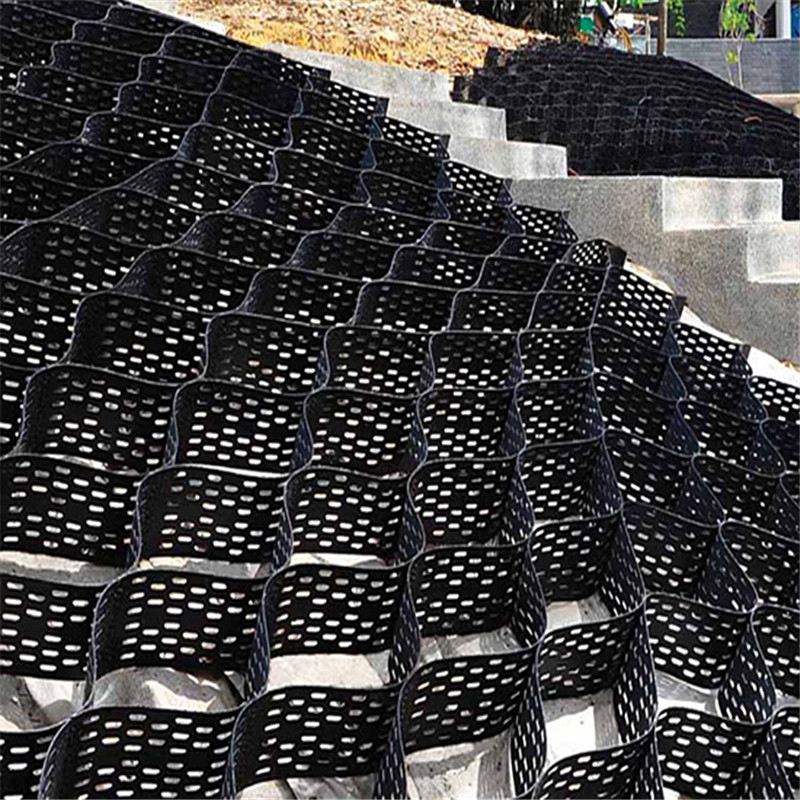Description

Construction method:
1. Working face: some slopes have met the requirements, the slope restoration construction is in progress, and the working face will be provided successively. The slope flatness is related to the success or failure of grass planting protection in geocell. When the slope surface is uneven, the laying of geocell is easy to produce stress concentration, which will crack the welding joints of the cell and cause the cell to step across. Therefore, the slope must be leveled to the design requirements, and the slope shall be repaired manually to remove the pumice and dangerous stones on the slope.
2. The side slope of the paving cell shall be provided with a main drainage ditch system, and a distance of 4m shall be maintained between the two adjacent ditches. The drainage ditch is connected with the highway side ditch, so that the road area water flows into the drainage channel along the side ditch and into the edge of the highway, so as to prevent the road area water from scouring the cell slope protection.
3. The top of the slope shall be leveled to remove some sundries that are not conducive to the laying of the cell, so as to keep the slope flat and solid. A layer of high-quality soil can also be sprinkled first to facilitate the growth of plants.
4. The cell shall be laid from top to bottom in the main stress direction, so that the cell sheet weight is perpendicular to the highway subgrade. Never lay horizontally.
5. Fully open the cell assembly, and nail a hook shaped rivet pile into each cell at the top. The length of the rivet pile is required to be twice the height of the cell itself plus 30cm. For example, for a 5cm cell, its rivet pile should be 2x5cm + 30cm, 40cm long, and for a 10cm cell, its rivet pile should be 2x10 + 30, 50cm long. Rivet piles can be nailed into the drainage ditch on both sides. Bamboo and wood piles can be used to open the cell, The middle and bottom can also use bamboo and wood pile like tensioning chamber. The top riveting pile mainly plays the role of hanging and riveting lattice chamber. Better materials should be used, such as steel rod. The steel pole must be perpendicular to the slope, and the other mainly plays the role of tensioning chamber during construction. The available materials are relatively simple.
6. After the cell is tensioned and riveted, fill the cell space from top to bottom with high-quality soil suitable for planting turf or grass seeds_ It is better to use 1.2 times of the height of the cell, beat it firmly, and plant vegetation in time.
7. When used on the lower slope of the highway, the drainage ditch shall be connected with the shoulder retaining ditch to facilitate the drainage of water in the road area without scouring the slope protection. When used on the upper slope of the highway, a blocking ditch shall be set on the top line of the upper slope to make the ponding blocking ditch at the height of the upper slope flow into the drainage ditch to avoid ponding directly scouring the slope protection. The geotechnical cell with higher height shall be used on the upper slope as far as possible.
8. After the construction is completed, the re inspection work shall be done well. If the tensioning is not fully divided and the top riveting pile is not solid, it shall be reworked in time until the turf or grass seed completely survives.
Precautions for geocell construction
1. The hole forming position of anchor rod must be located at the opposite corner of the cell To ensure that the weight of the cell can be transferred to the anchor bolt.
2. The cells must be completely connected with each other to form a piece and connect as a whole.
3. In order to prevent the scouring of water flow on the cell, a waterproof ridge is built on the top of the slope to prevent rainwater from pouring into the cell from the top of the slope and dredge the place where the drainage is blocked in time.